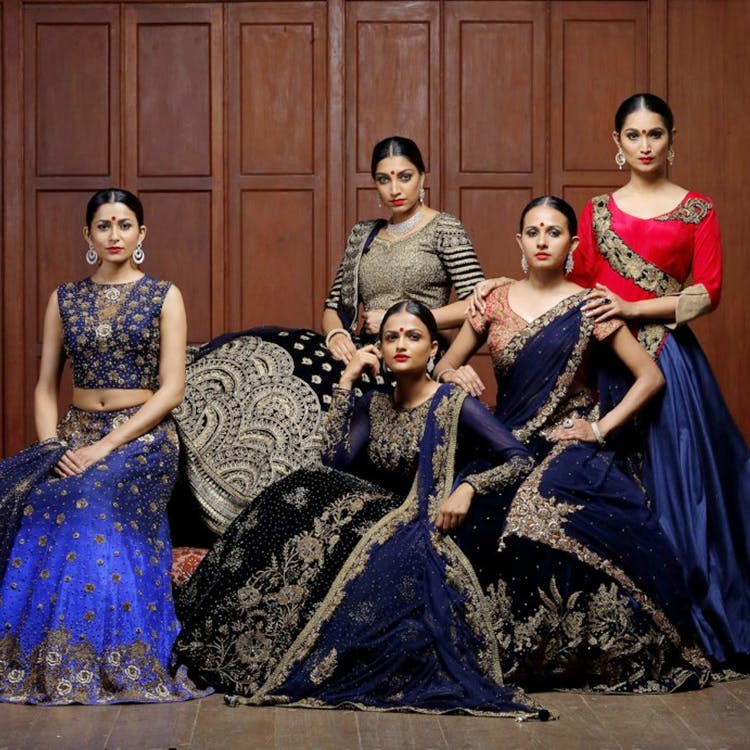
Dress in Chennai
Keep in mind that the people in Chennai are very simple and believe in leading a simple life. They are very traditional and particular about their customs and value system. They strictly adhere to the age-old religious and social practices and obey them with utmost sincerity. It’s their cultural legacy and they are extremely proud of it. The conventional style of selection and adoring different traditional attires confirms this fact. Women are respected and given high regard in South Indian families. As a result, most of the women wear saris, with exquisite designs and flowing fabrics, further enhancing their traditional Indian beauty. Men usually wear a dress called veshti (lungi) and shirt. However, due to the modernization of Chennai, people are commonly seen wearing western attires including shirts, jeans, and t-shirts. Although, western wear is not very popular except in the urbanized areas. Thus, if you are still wondering how to dress up in the city; just remember that elegance and decency is the key to choose dresses before packing a bag to Chennai.
Lying at the southeast coast of the country at the Bay of Bengal, experiencing a tropical climate, Chennai really wants you to think twice before picking up any dress from your cupboard. As the climate in Madras is terribly hot, cotton would be the most preferred fabric to wear in the city. The lighter shaded your clothes are, the better it is. The scorching heat combined with occasional rainfall may trouble you so do not forget to make space for a raincoat and umbrella in your bag. If you are visiting Chennai in winters, which is the apt season to come to Chennai, do not burden yourself with heavy woollen clothes as the temperature seldom falls below 20 degree Celsius.
So, pack your bags with comfortable and light attires, so that you can beat the heat. Besides, make sure that the dresses should be decent and not too revealing. Nudity is absolutely prohibited at Chennai beaches. Have a happy stay in Chennai!
Saree
Sari found a special place among their costumes, saree, blouse and half saree is the traditional dress for women in Tamil Nadu. Sarees can be worn by women to temples, offices, marriage and parties. The famous Tamil poetry cilapattikaram portrays women in sarees. South Indian saree with zari work is famous all over India.
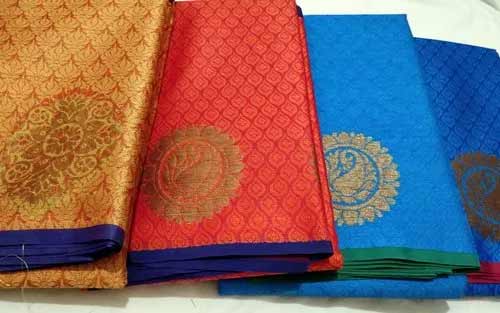
Kanchipuram Saree
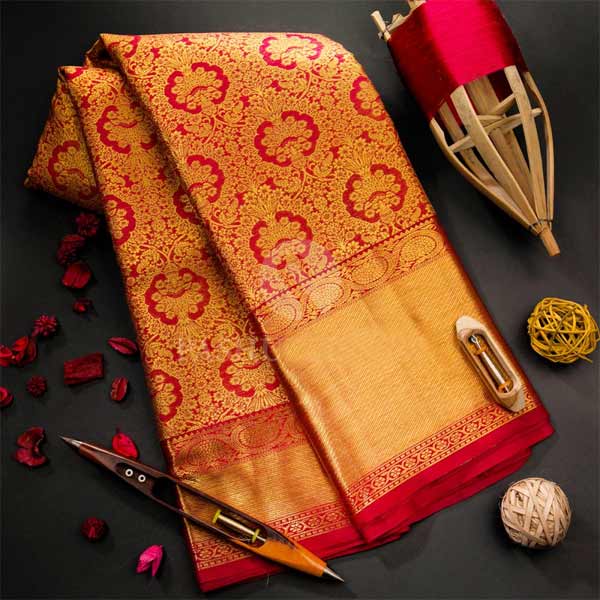
Kanchipuram saree is the well-known variety of saree in tamil nadu is known for its exceptional styles. These sarees are made from wdifferent types of materials like silk, cotton, chiffon, pattola silk, and crepe silk The colour and texture of these sarees differ from the other North Indian sarees. The length of the sarees ranges from five to six yards. Mostly brahmin women after getting married wear these sarees.
Pavda
Pavada or the half-saree is another traditional outfit of Tamil Nadu especially worn by girls before getting married. This half saree consists of a full-length skirt with a blouse and shawl known as davani. Pavada symbolises the young age and beauty of Tamil girls.
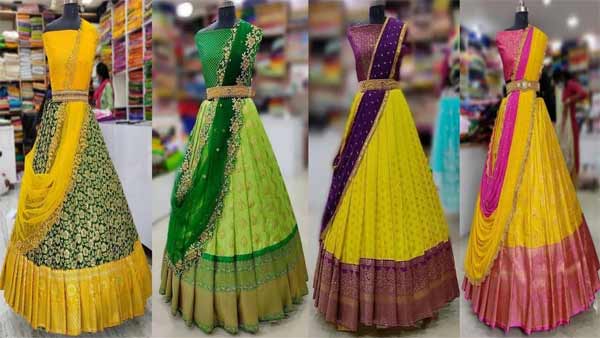
Salwar Kameez
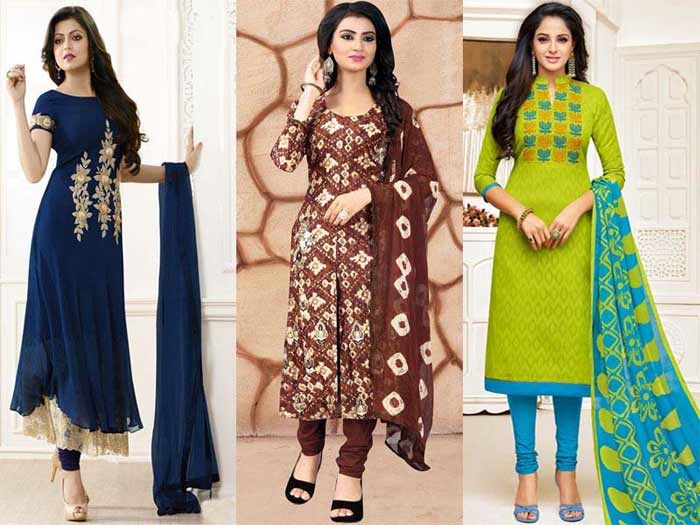
These days salwar Kameez is worn by women in Tamil Nadu. It consists of a combination of salwar ( a kind of loose trouser) and kameez ( long top)
Kalamkari
Kalamkari, which literally means ‘pen work’, are paintings done on textile with vegetable or natural dyes. The Kalakmari tradition flourished throughout India from the 14th century onwards, but gained popularity and acquired its name during Muslim rule.
The technique began to die out with the introduction of machine-printed textiles, and now only a small number of artisans practice the craft in centres in the southern states of Andhra Pradesh and Tamil Nadu. Chief among these are Srikalahasti and Masulipatinam. The Kalamkari Unit in Kalakshetra uses methods based on extensive research in both of these areas.
A devotional strain of the craft developed in Srikalahasti which was a centre of pilgrimage. The temple Kalamkaris are narrative, and based on themes from Hindu mythology, describing anything from a single episode to the whole sweep of an epic. The only tool used for these intricate works was the Kalam, a thin bamboo stick sharpened to a point like the nib of a pen. Above this nib is a compact ball of hair which holds the liquid dye used as ink. In time, the Srikalahasti tradition incorporated perforated stencils and still later, hand carved wooden blocks used for patterns.
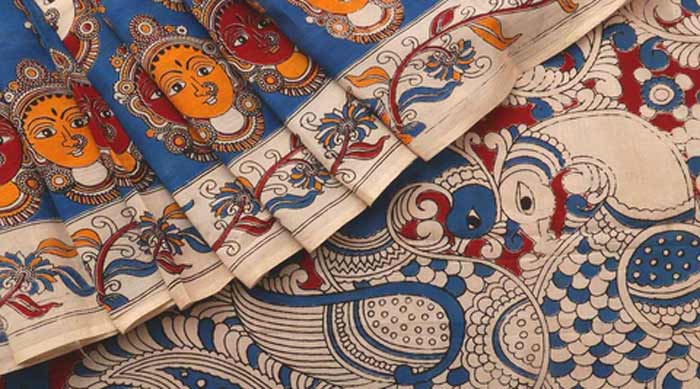
In the Masulipatinam tradition, the outlines and main features of all the designs are printed with hand-carved blocks and only the details are painted by hand. Old traditional blocks, many with Persian motifs, have been used for many years.
The dyes used in Kalamkari are colors extracted from plants, roots, leaves and similar vegetable matter, combined with minerals like iron, and mordants like alum. These colors are fast, but are not harsh and gaudy, and they acquire a certain clarity wash by wash. Harsh chemicals are never used, and the traditional methods followed for bleaching and printing impart a mellow beauty and durability to the fabric which is characteristic of Kalamkari.
Kalamkari work is a time-consuming process, involving as many as fifteen steps. This includes bleaching, the application of myrobalam, painting and printing, washing, dyeing, bleaching, starching, waxing, indigo vat dyeing, wax removing, bleaching, starching, the application of yellow and green colors, the application of alum and bleaching. Sunlight is the main bleaching agent. Not being photo – sensitive like chemical dyes, vegetable dye printed fabrics do not fade in unsightly patches, even with repeated washing and exposure to sunlight.
Traditional Dress of Tamil Nadu For Men
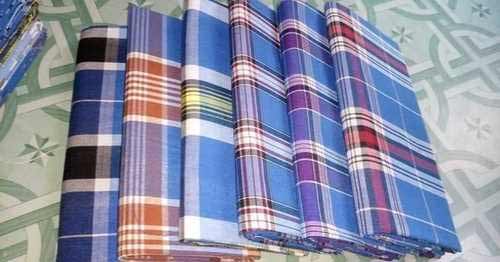
The traditional dresses of men also look as elegant as women’s. Generally, they use lungi and angavastram. The traditional lungies were invented in south India. Lungi is the most common part of the men’s outfit.
It is a rectangular piece of cloth generally made of pure cotton. It is wrapped around the waist and thighs. The lungies are available in various colours but white coloured lungies are the traditional dress of Tamil Nadu.
Men in Tamil Nadu wear lungies to marriage parties also. Angavastram is another important part of Tamill dress. It is a piece of cloth to be wrapped around the shoulders. In earlier days angavastram was used as upper clothing but nowadays it is used above the shirt.
India is a land of tradition, culture, customs and rituals that vary from different states of the country. And an Indian wedding consists of various customs and cultures.
The attire that a bride wears on her wedding day is connected to the customs and traditions of her family. The jewellery and other accessories she wears also has some significant meaning.
The Tamil brahmin brides wear a 9 yard long rich silk kanjivaram saree whereas the non-brahmin brides wear a regular six yards saree.
The kanjivaram sarees are available in bright colours along with contrasting borders and different patterns are drawn in the saree with golden threads.The hair is decorated with flowers and golden ornaments.
Tamil brides are adorned with heavy gold jewellery which is passed on from generation to generation in the family.
The prominent jewellery pieces consist of metti ( toe ring made of silver), kolusu( an anklet made silver worn around the ankles), vanki ( floral or peacock design armlets made from gold or silver), maanga malai (necklace), oddinayanam ( hip belt made of silver or gold), nose ring, earrings, thalaisaman, and jadanagam.
Kanjivaram saree along with ornaments completes the look of a Tamil bride.
Tamil weddings are very different from the other Indian weddings as Tamilians are known for simple living and high thinking.
